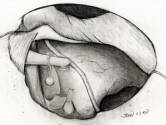


JOHN LI, M.D.
OTOLOGY NEUROTOLOGY RESOURCES
210 Jupiter Lakes Blvd #5105
Jupiter, FL 33458
Phone: (561)-748-4445
Fax: (561)-748-4449
Email: Dr-Li@Dr-Li.net
Stapedectomy for Otosclerosis
Stapedectomy, a treatment for otosclerosis invented in the 1950s, allowed surgeons to surgically replace the stiff stirrup bone with synthetic vibrating devices. Modern refinements such as laser techniques have made this surgery safer and perhaps more successful. Stapedectomy is a very delicate and precise operation done under a microscope. There is very little margin for error. However, when done properly, the results are typically fantastic.
Otosclerosis is a relatively common cause of hereditary hearing loss. Otosclerosis is an abnormal process of microscopic bone formation in the walls of the inner ear. This growth causes the stapes bone to become frozen in place or stuck to the surrounding bone. When the stapes becomes frozen or fixed, it cannot vibrate freely to transmit sound waves to the inner ear fluids. Hearing is impaired. Otosclerosis occurs in about 10% of the adult population, but in only 1%, otosclerosis involves the stapes bone where it actually causes interference with hearing. When otosclerosis is present in other places in the middle ear, it causes few if any symptoms.
 In a normal ear, the outer ear funnels sound through the ear canal to the ear drum. The ear drum's movements are transferred to small bones in the middle ear. One of these bones is the stapes -- the smallest bone in the human body. The stapes bone, also called the "stirrup," vibrates in and out of the oval window, which creates "waves" in the inner ear fluids. This fluid movement stimulates the sense organs of the inner ear which in turn, stimulate the hearing nerve. Otosclerosis disrupts this hearing process. The hormonal fluctuations of pregnancy are known to accelerate the otosclerosis process.
In a normal ear, the outer ear funnels sound through the ear canal to the ear drum. The ear drum's movements are transferred to small bones in the middle ear. One of these bones is the stapes -- the smallest bone in the human body. The stapes bone, also called the "stirrup," vibrates in and out of the oval window, which creates "waves" in the inner ear fluids. This fluid movement stimulates the sense organs of the inner ear which in turn, stimulate the hearing nerve. Otosclerosis disrupts this hearing process. The hormonal fluctuations of pregnancy are known to accelerate the otosclerosis process.
Treatment of Otosclerosis
Medical treatment: There is no medication that will improve the hearing in patients who have otosclerosis. There is some evidence that sodium fluoride decreases the rate of hearing loss, but it does not reverse the process
Surgical treatment: Stapes surgery (stapedectomy or stapedotomy) is recommended for patients with otosclerosis who are appropriate candidates. The operation is performed under local or general anesthesia, usually as an outpatient procedure. Recovery is usually short. Over 90% of these operations successfully improve or restore the hearing.

Drawing of a Right Ear Stapes procedure, Ear Drum is raised and reflected forward and the stapes prosthesis is in place.
Stapes surgery is performed through the ear canal. A small incision may be made in the ear to harvest a graft for use in the operation. Using the operating microscope, the ear drum is lifted like a hatch forward and the “stuck” stapes is removed. Usually, a small opening is made through the stapes plate with fine instruments, a micro drill, or a laser. Tissue is placed over the opening to the inner ear and a prosthesis or piston is inserted and then attached to the incus (the anvil, the second of the three middle ear bones). The ear drum is then replaced in its normal position and the ear canal is filled with ointment. The stapes prosthesis allows sound vibrations to pass from the ear drum to the inner ear fluids. The hearing improvement obtained is usually permanent.
During surgery, the surgeon places packing in the ear canal. One may not notice any improvement in hearing until the doctor removes the packing 2-3 weeks after surgery. Improvement in hearing will often be apparent within three weeks following surgery. Maximum hearing, however, is obtained in approximately 4 months. Initially, many patients complain of a "hollow" sensation of sound, as though they were hearing from the bottom of a barrel. Sounds may have a harsh, shrill quality or may seem abnormally loud, but they will gradually become normal.
The ear drum will heal quickly. Two weeks following surgery, one may resume normal activities, including flying. Until then, avoid blowing the nose for one week after surgery, and keep water out of the ear for at least two weeks. When shampooing or showering, place a cotton ball covered lightly with petroleum jelly into the outer ear canal. Do not go swimming. The doctor may give a prescription for antibiotics to be taken orally.
Complications
Complications are very rare. If at any time after surgery one experiences sudden hearing loss, pain, dizziness, or any new symptom related to the operated ear, notify the doctor immediately. Early intervention can avert problems.
Dizziness is normal for a few hours following stapedectomy and may result in nausea and vomiting. Some unsteadiness is common during the first few post-operative days; dizziness on sudden head movements may persist for several weeks. On rare occasions, dizziness is prolonged.
Because a small taste nerve (the chorda tympani) runs through the ear, it is not unusual for patients to experience altered taste sensations for several weeks or months following the stapedectomy. Normal taste sensations usually return eventually.
In about 2% of patients the hearing may be further impaired due to the development of scar tissue, infection, blood vessel spasm, irritation of the inner ear, or a leak of inner ear fluid (called a fistula). In 1% of patients, complications in the healing process may be so great that there is severe loss of hearing in the operated ear. This may be to the extent that one cannot obtain benefit from a hearing aid in that ear. For this reason the poorer hearing ear is selected for surgery.
A perforation (hole) in the ear drum membrane is an unusual complication. It develops in less than 1% of patients and is usually due to an infection. Fortunately, should this complication occur, the membrane often heals spontaneously. If healing does not occur, surgical repair (myringoplastly) may be required.